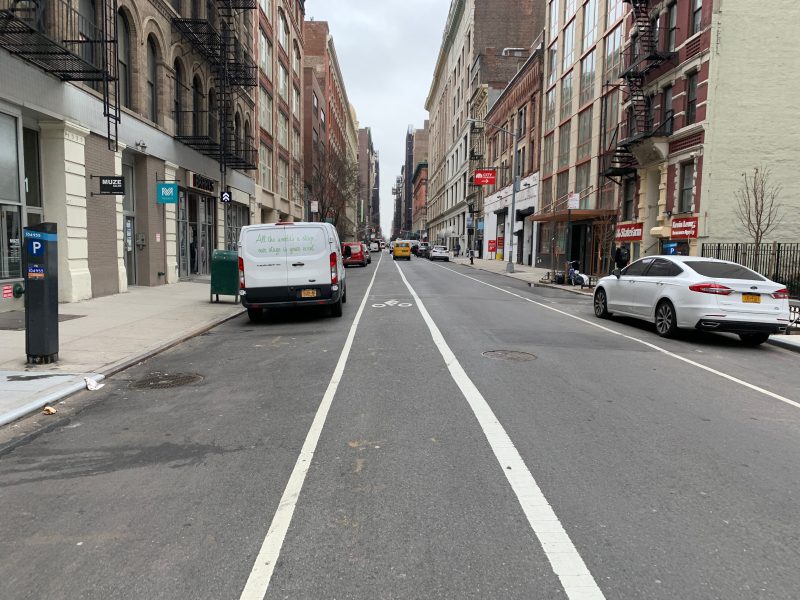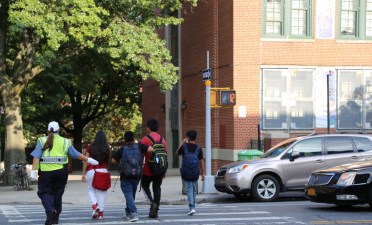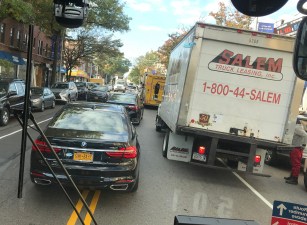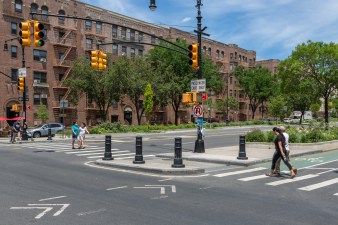Mayor de Blasio’s ‘Safety Third’ Policy Rears Ugly Head at Manhattan Precinct

Pedaling west to east along W. 20th Street in Chelsea is a pleasure — a wide street with a painted bike lane and relatively few cars gives a cyclist a rare feeling of safety.
Then the rider gets to the block between Eighth and Seventh avenues:
Suddenly, the painted bike lane disappears. The roadway narrows as twice the number of cars are crammed into curbside spaces thanks to angled, instead of parallel, parking. There are cars illegally parked, parked at hydrants, double-parked, parked in driveways. Cars cars cars.
And then the cyclist sees why: the block is home to the 10th Precinct stationhouse.
The now-jittery cyclist continues pedaling across Seventh Avenue, and the bike lane (and with it his feeling of calm and safety) returns.
Streetsblog has long documented the reckless driving of NYPD employees in their private cars — and the cops of the 10th Precinct are no different. Thanks to the Howsmydrivingny.nyc database, we ran the plates of every car parked in NYPD-only spaces or parked illegally with placards, PBA cards or log books and discovered:
- 83 percent of vehicles have been ticketed at least once (above the 71.5 percent citywide police average).
- 58 percent had received at least one camera-issued red light or speeding ticket (roughly the 59 percent citywide police average).
- 45 percent had received multiple moving violation tickets (well above the 38 percent citywide police average).
So the cops themselves are a danger to their community. But in most neighborhoods, crucial road-safety infrastructure doesn’t just disappear simply because Mayor de Blasio insists that police officers have free parking at their workplace.
It not only creates the appearance of danger, but actual, documented danger. In other words, Mayor de Blasio’s commitment to police officers’ car commuting has a quantifiable public health risk.

The city’s own data show that the Chelsea precinct block is significantly more dangerous to all road users than the blocks on either side of it.
Here’s what city data on Crashmapper tell us about on W. 20th Street in 2019:
- Between Ninth and Eighth avenues (with bike lane): three crashes total.
- Between Eighth and Seventh avenues (precinct block without bike lane): 13 crashes total.
- Between Seventh and Sixth avenues (with bike lane): three crashes total.
So there were 333 percent more crashes on the precinct block last year than there were on each of the blocks on either side of it.
And since 2014, there have been 17 crashes on the precinct block (injuring one pedestrian) versus the same three crashes on the block to the west. That’s 466 percent more danger!
We’ve asked Mayor de Blasio in the past about the danger posed by recklessly driving cops, but he maintains that his officers — 51 percent of whom live in the suburbs — “need” to drive to work.
“We will purchase parking lots, we will lease parking lots, parking garages — whatever it takes … so that our firefighters, our police officers, our EMTs actually have a place that they know they can park,” the mayor said last year when asked about the parking entitlement for cops. “Many officers feel they have no choice [but to drive to work]. … This is a very worthy investment.”
We reached out for new comments from City Hall and the Department of Transportation, which created the life-saving street safety improvements on W. 20th Street (and also kept it from the precinct block). We will update this story if we hear back.




